Grace Amidst Messiness

“Throughout the years, Calli has taught me so much about living with frailty and an illness that is not only ‘messy,’ but which can lead to more and more serious and even fatal afflictions. I have learned to let her be a dog despite my desire to keep her from doing things that might aggravate her condition. I have learned to be grateful for the ‘messes’ I need to clean up after she regurgitates, because I know that, without the messes, I probably would not have this beloved creature in my life.”—Robin White
Wing + Prayer
By The Reverend Robin White
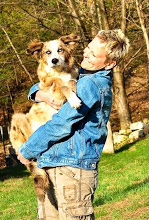

LAKE HARTWELL South Carolina—(Weekly Hubris)—November 2019—The Blessing of the Animals, which so many congregations, worldwide, celebrate in honor of St. Francis of Assisi, is the perfect opportunity for us to tell the stories of our furry family members.
Please indulge me as I tell you (briefly) the “tail” of my own muse and spiritual guide, my beloved Calliope. In Greek Mythology, Kalliopē, meaning “beautiful-voiced,” is the Muse who presides over eloquence and epic poetry; so called due to the ecstatic harmony of her voice. Hesiod and Ovid considered her to be “Chief of all Muses.”
The year 2009 had been difficult for me. My dear friend and surrogate mother, whom I had known and loved nearly all my life, died after a suffering a severe stroke. My faithful companion of nine years, a goofy and always happy, yellow Labrador Retriever, suddenly died of an aneurysm. A few months later, my 70-year-old father was diagnosed with terminal cancer. I was grieving and lost, and in need of comfort, companionship, and unconditional love.
Three days before Thanksgiving, after a month of searching the internet for a rescue puppy, I discovered a Double-Merle, Australian Shepherd who, according to her description on the rescue site, might possibly be blind and deaf.
After doing some research, I learned that “Merle” is a gene and that a “Double-Merle” is a dog with two Merle genes. Double-Merle puppies are born when both parents are Merle. The thought of partnering with a dog that could be both blind and deaf was daunting. Yet, the thought of this adorable and sweet puppy, living life blind and deaf in a shelter with 150 other dogs, was horrifying to me. I immediately emailed the shelter with my application and expressed my desire to drive to Georgia, ASAP. I didn’t sleep much that night, and I got up in the morning absolutely convinced that this blue-eyed beauty would come to join me in the mountains of West Virginia.
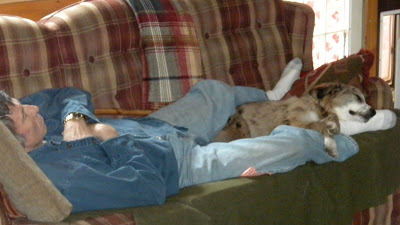
Later that morning, I received an email informing me that the adoption had been approved. An hour later, I was on my way to Georgia to pick her up!
When I arrived at the fenced-in “dog rescue,” where it seemed there were hundreds of canine fur balls barking at me, I was met at the gate by the woman who was in charge, a 14-pound bundle in her arms. She handed off the smelly, scrawny three-month-old pup, and it was a done deal . . . and I mean it, a done deal: that dog crawled inside my heart and that was it.
I learned quickly that she was neither blind nor deaf. She did, however, have a cough, and seemed to have weakness in her back legs.
After a visit to the Animal Hospital for a “check-up,” I was horrified to discover that Calli had Demadex Mange (although she had no symptoms). My veterinary doctor explained to me that mother dogs pass the mite on to their offspring, and that most puppies’ immune systems deal naturally with problem. Calli, however, for some unknown reason, probably had a compromised immune system which was most likely the cause of the mange.
As a result, much to her vexation, Calli had to make several trips back to the vet for special “baths” to deal with the mange.
Within the first week of our time together, I began to notice that Calli did not romp and play like most pups her age. She had very little energy and seemed to be “regurgitating” or vomiting up everything she ate. After a little online research, I became convinced that she had a condition known as Megaesophagus. After a few days of her regurgitating both food and water, I took her back to my vet, who assured me that Megaesophagus rarely presented in this particular breed of dog and that Calli was probably just doing what puppies do . . . eating too much and throwing up. I convinced the vet, however, to do a barium enema. Sure enough, the X-ray showed Megaesophagus. Calli’s esophagus was enlarged at the stomach, and food sat there, with all the enzymes churning and churning, the food never making it to the stomach. Thus, the regurgitation.
What I learned next from my “country, mostly farm animal” vet is that most dogs with this condition are euthanized because they either die of starvation, or pneumonia as a result of aspiration. With tears in my eyes, I assured her that I was not about to euthanize the dog who had just a week earlier taken up residence in my heart. I bundled Calli up in her blanket and walked out of the office, determined to find a solution.
I spent hours researching Megaesophagus, learning as much as I could about how to help Calli become healthier. I discovered that Megaesophagus was most likely the cause of her compromised immune system as well as the weakness in her hind legs; that her cough was probably due to aspiration, and that antibiotics would probably prevent pneumonia.
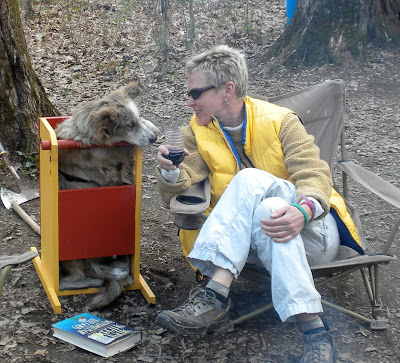
The day after her diagnosis, I worked to design and build a chair for her to sit in during and after feeding. I looked at photos of the “Baily Chair” used for other dogs with this condition and, using scrap wood, built the first prototype, with the understanding that I would modify and rebuild it as Calli grew. Together, we figured out what worked best for her. The chair was designed to keep her in an upright position so that gravity would pull the food into her stomach.
I began feeding her a high-calorie and healthy dog food that I put through a coffee grinder and then mixed with water to create a “gruel.” The results were almost immediate. Although she was still quite thin, she began to gain a little weight, and there were fewer incidents of regurgitation. It took a little while for her to get used to sitting in the chair but, over time, she learned to remain in the chair for from 20 to 30 minutes after eating. To keep her occupied, I smeared a high-calorie gel and molasses or honey in the bottom of her dish.
I also found that exercise helped with her digestive process. With Megaesophagus in dogs, feeding late in the day is often problematic. I experimented with feeding times and amounts and consistency of the food, trying to figure out what worked best for Calli. The goal was to keep regurgitation to a minimum so that she would continue to gain weight and build muscle mass.
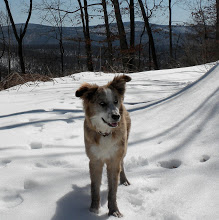
In January of 2010, on a warm and sunny day in West Virginia, I took Calli on her first big hike. We climbed a mountain to my favorite ridge, where I became so warm that I stripped off my down jacket and tied it around my waist. After a few hours of hiking, we returned to the car, where I noticed that I had lost the orange leukemia wrist band I wore in honor of my late father.
Four months later, after much snow, ice, and many winter storms, we returned to my favorite hike and, on top of the ridge, I noticed Calli carrying in her mouth what I thought was an orange peel. When I reached down to retrieve it, I saw that it was the orange leukemia bracelet I had lost the previous January. Calli grinned at me as I pulled the treasure from her mouth . . . .
For the first couple of years, I had good and bad days with Calli’s Megaesophagus. There were many nights when I walked the floor, holding her upright, willing the food and water to move from her esophagus to her stomach. Whenever I begin to feel as though I had found a routine that worked, suddenly it didn’t work any longer and I was left scratching my head. There seemed to be no rhyme or reason to the regurge, which was a difficult reality for someone like me, who always wants to have answers and some control.
Over time, Calli’s energy began to increase and her tiny frame began to fill out. She learned to communicate with me through her steel-blue eyes and her beautiful voice (which took on many different pitches and tones).
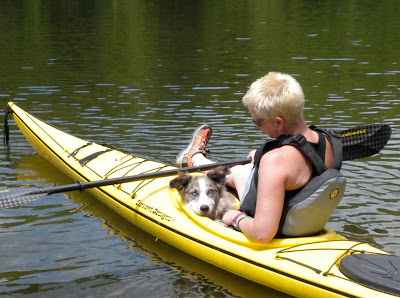
And then, it was as if it happened overnight, the regurge stopped. Calli no longer needed the chair or gruel. She ate and drank like a normal dog, but on a raised planform. There is no cure for Megaesophogus, so what we were experiencing was a miracle—even my vet used that word.
For several years, Calli lived life like a normal dog. We hiked mountains together. When I went camping, she kept me warm at night and guarded my little pup tent. I taught her to ride in a kayak, which became one of her favorite activities. She sat with me as I sat with my dying father and, when he finally died, Calli climbed in to be with him, refusing to move until I had to physically lift her from the bed when the mortician arrived.
When Calli turned nine years old, everything shifted again, and the Megaesphogus was back with a vengeance. I had hoped that it was just a short-term relapse but that was not to be the case.
Because of her painful hips, I made the decision not to return her to the upright position in the chair, but I spent months trying different approaches to food and water. For the past year, I have been soaking her food in water, running it through a food processor, and forming golf-ball-sized “meatballs,” which I feed to her by hand. This has worked to some extent, though drinking water is a huge issue, and I have learned to keep lots of towels around to mop up the mess.
Throughout the years, Calli has taught me so much about living with frailty and an illness that is not only “messy,” but which can lead to more and more serious and even fatal afflictions. I have learned to let her be a dog despite my desire to keep her from doing things that might aggravate her condition. I have learned to be grateful for the “messes” I need to clean up after she regurgitates, because I know that, without the messes, I probably would not have this beloved creature in my life.
Calli is by far the most sensitive, intuitive dog I have known, and I have learned from her the authenticity of a “sixth sense.” She knows before I do that something is disturbing or upsetting me. She swoops in, either climbing onto my lap or pressing her face into my legs, offering comfort and solace. I have learned from Calli how to receive care and assume grace. Each and every single time she regurgitates and I rush in to “clean up,” she looks up at me with those steel-blue eyes as if to say, “I’m sorry,” while, at the same time, “Thanks for understanding and accepting me with all my flaws.”
I think I have learned from Calli what God must experience daily. When we find ourselves, so often, in “messy” circumstances, we also find, so often, that we are loved and accepted . . . despite our messes.
![]()
Note: To read more about Calli, go to Robin White’s blog, “Calli Pup: The Awesome Aussie.”
4 Comments
judy
I am teary eyed in love with you and Calli.
Robin White
Love you too, Aunt Judy! Thanks for reading my column.
Don Schofield
A lovely, moving “tail,” Robin (I don’t believe I made that pun). What a heart you have!
Jean White
Robin, you have always been a loving child of God and an inspiration to many. I am so very proud of you. My love to you and my wonderful grand dog Calli.